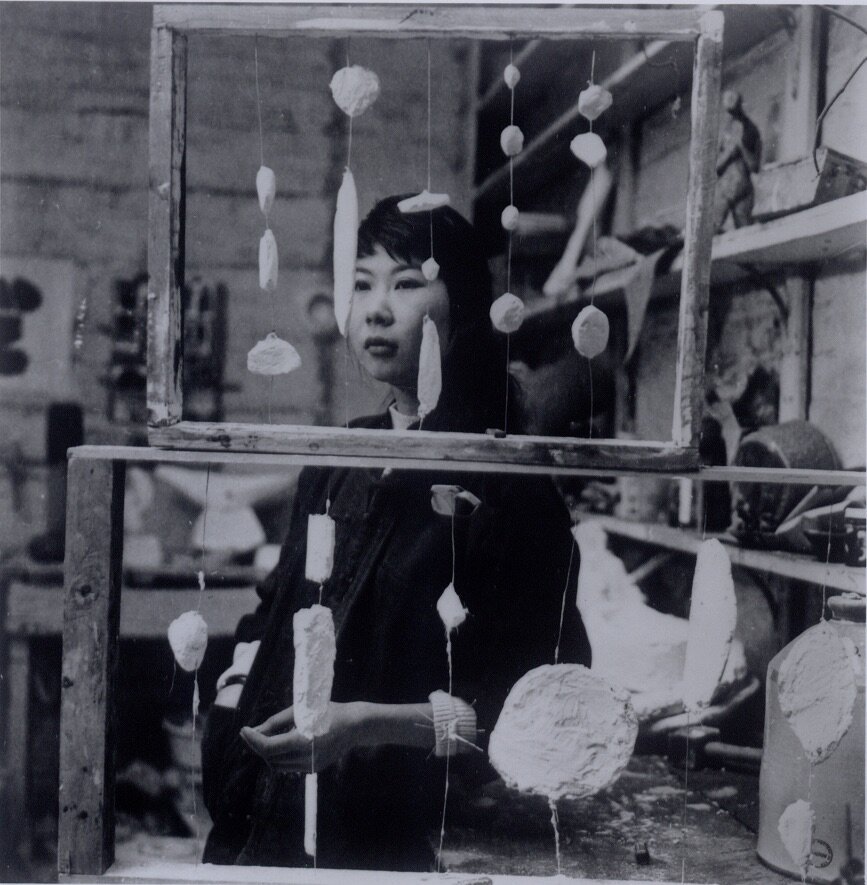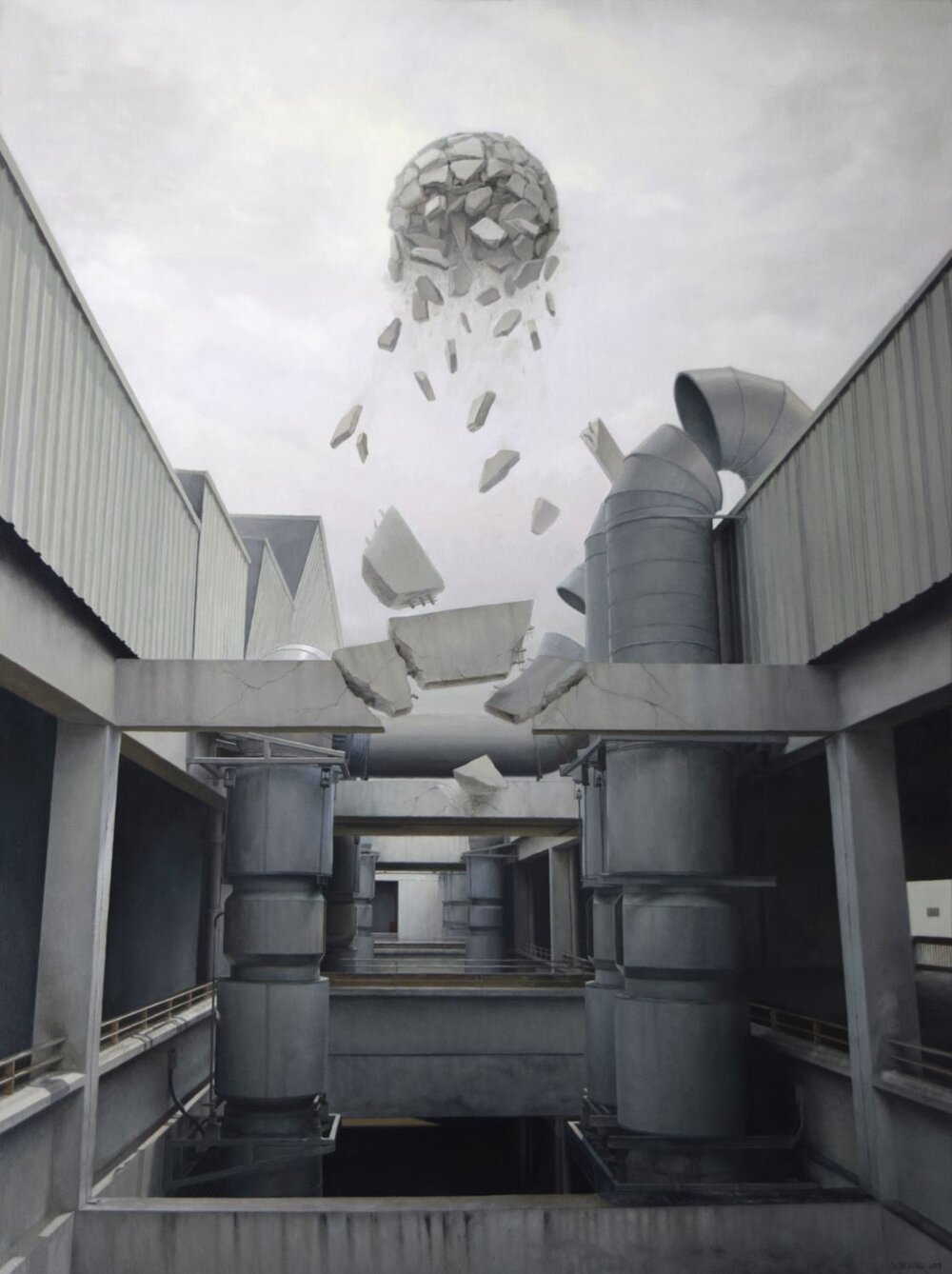Review of ‘Kim Lim: Carving and Printing’
Imprinting a legacy at Tate Britain
By Liew Yuqi
Kim Lim in her studio with ‘Abacus’, 1959. Image courtesy of the Estate of Kim Lim.
‘Intervals I plus II’ (1973) appear like conjoined wooden ladders with rungs split cleanly in half, leaning against the wall leading up to nowhere. Regardless of the imagery they allude to in the depths of one’s imagination, these carefully assembled timber amalgamations were instruments Kim Lim used to manipulate space, which she made almost tangible through the carving of light and tracing of shadow.
My attention is drawn to the space between two intersecting planes, where wall meets floor in a handshake made apparent by the timber sculptures. It is an ethereal handshake, and not just between its two planes, but one which extends across the globe. Beyond London, the same sculpture exists at the National Gallery of Singapore, both of which were birth places to Lim — the former of her ambitions to pursue art and the latter the realisation of her artistic endeavours. Thus, the timber ladder is apt for this biographical curation, allowing us to climb into Lim’s world.
‘Kim Lim: Carving and Printing’, spotlight display at Tate Britain. Photo by Johnny Turnbull, © Estate of Kim Lim.
Re-opening its doors to the public for over a month after the relaxation of lock-down measures, ‘Kim Lim: Carving and Printing’ at Tate Britain casts a spotlight on the Singapore-British artist (1936-1997). Featuring a concise curation of her earlier works, captured in time and space between 1958 and 1960, and from 1969 to 1974, this retrospective serves to cement recent interest in the prolific artist. After almost a 15-year hiatus from 1999, Lim’s works began resurfacing into public consciousness in 2014 at the Roche Court New Art Centre, followed by both STPI – Creative Gallery and Workshop in Singapore and Sotheby’s S2 in London in 2018. This Spotlight feature at Tate Britain, curated by Elena Crippa, comprises of wooden sculptures and works on paper. They contemplate Lim’s early negotiation between the two mediums, to which she accorded equal significance and attention.
At 18, Lim arrived in London in 1954 determined to pursue art. She enrolled at St Martins’ School of Fine Art, studying under Anthony Caro, and subsequently at the Slade School of Fine Art. These were formative in her commitment to printmaking and sculpture, working with wood metal and later, stone. In her oeuvre, she was concerned with the essence and ‘truth’ of each material, retaining and expressing their natural qualities.
Kim Lim, ‘Sphinx’, 1959, wood and metal, 41 x 40 x 13.5cm, The Artist’s Estate, London. Photo by the artist, © Estate of Kim Lim.
The surfaces of ‘Sphinx’ (1959), a sculpture of equipoised wood off-cuts and metal, were scorched to preserve its original qualities while affording sections of different distinctive textures under the light. Writer Martin Holman describes Lim’s explorations as unfolding “in a cyclical way that thrived on invention and review”. This is discernible through thoughtful curation, where the sculpture is presented alongside her lithograph of the same name, made the following year. This coupling draws attention to the relationship between sculpture and print. To Lim, they were not just diametrically opposed but two points on the same circle in revolution.
Kim Lim, ‘Sphinx’, 1960, lithograph on paper, 38.5 x 52cm, The Artist’s Estate, London. © Estate of Kim Lim. All Rights Reserved, DACS 2020.
Lim had a deep reverence for the natural world. She was also greatly inspired by her extensive travels across Europe and Southeast Asia, feverishly surveying art and objects of antiquities. It was through these exposures that guided her explorations on the harmonies of “form, space, rhythm, and light.” Composed from a series of repeating and mirrored geometric forms, the rhythms in the etchings of ‘Ladder Series I’ to ‘Ladder Series V’, all completed in 1972, trigger our perceptual investigations of the interstices between lines and edges. These selected etchings on paper serve as a blueprint for us to understand the rectilinear timber sculpture ‘Intervals I plus II’ displayed adjacently. One begins to witness the evolution of her pursuits, where she wielded light as a tool to articulate space like a “physical substance”.
“Furthermore, the exhibition resonates with a larger discourse of addressing the imbalances of art history, where omissions are being redressed in the narrative of British art.”
Featured as part of the Collection Route ‘British Art 1930 to Now’, this exposition confers due recognition to Lim as a seminal figure in the legacies of Art Modernism and Minimalism. Furthermore, the exhibition resonates with a larger discourse of addressing the imbalances of art history, where omissions are being redressed in the narrative of British art. In a podcast series ‘Sculpting Lives: Women & Sculpture’, Hammad Nasar, Senior Researcher at the Paul Mellon Centre for Studies in British Art, noticed Lim’s relative absence in the histories of art in Britain. This was despite the artist’s illustrious career, including a large body of British public works, second only to Anish Kapoor. This also brings into question the role public galleries play in mapping the picturesque landscape of British art and the opportunity for charting new narratives.
Complementing the complexity of conversations that arise from the works, there is a chronological clarity to the curation, which is especially informative for those who are yet unacquainted with the artist, anchored by the display of rarely or never-seen-before wood carvings and lithography which predate the development of both minimalism and conceptual art. Towards the end of the curatorial timeline, a pedestal of archival materials offer to conclude the biographical line on an intimate note. They include a sketching of nature, photographs she took of her sculptures, a manuscript of the author’s musings, a printing block, and a striking portrait of the artist. This was the part of the exhibit I appreciated most, besides ‘Intervals I plus II’, as it provides a glimpse into how Lim perceived herself and her work.
Kim Lim, ‘Bridge I’ and ‘Bridge II’, 1960, lithographs on paper, ‘Chess Piece’, 1960, wood and metal sculpture, ‘Untitled’, 1959, and ‘Split Red’, 1960, lithographs on paper. Photo by Johnny Turnbull, © Estate of Kim Lim.
As an artist who is both female and foreign, Lim had always been conscious of the state of being seen as “other”. Bianca Chu noted on ‘Sculpting Lives’ that Lim existed between two worlds, and though it felt “isolating at times” with a “sense of not belonging”, there was also a sense of “freedom, a certain feeling of detachment from which one could view both East and West”. The position of the in-between was a space for Lim to reflect on her identities as an artist which would continue to feed into her work and ambitions. Crippa understood Lim’s work as taking inspiration from contemporary developments as much as historical precedents. It exceeded the narrow scope of the western canon and is the expression of a transnational and cosmopolitan attitude that resonates with our time and aspirations. These observations are best understood in ‘Chess Piece’ (1960), an object composed of juxtapositions. A game of wits that exists differently in the East and West, the abstract totem is symbolic of a power struggle between two factions. Its form and material qualities appear ancient, but upon closer inspection one recognises the contemporary markings of an extraordinary artist.
“The orderly static dynamism of Lim’s works invokes a contemplative stillness one seeks in these tumultuous times.”
As we psychologically and physically navigate through the global pandemic, Lim’s artistic explorations appeal to our already heightened perceptions of space as we practise social distancing. Even the experience of viewing art has been modulated, as one abides to floor markings that prescribe a one-way route through the galleries. The orderly static dynamism of Lim’s works invokes a contemplative stillness one seeks in these tumultuous times. While we attempt to ease back into our familiar routines and practices, ‘Kim Lim: Carving and Printing’ leaves us with a sense of optimism for the future. It brings to light critical questions on legacy and urges us to be unafraid of carving out bold new boundaries on issues that demand redress.
‘Kim Lim: Carving and Printing’ is at Tate Britain from 7 September 2020 to 5 March 2021.
About the Writer
Liew Yuqi has been living between London and Singapore. Graduating into the pandemic with a Masters of Architecture at the Bartlett School of Architecture, he is happy to be able to visit museums and galleries again, recognising the deep connection between art and architecture. He also dabbles in film photography and loves botanical design.














